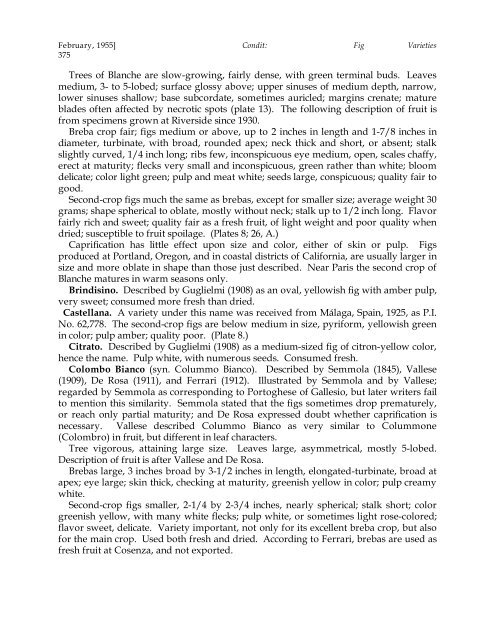Fig Varieties: A Monograph - uri=ucce.ucdavis
Fig Varieties: A Monograph - uri=ucce.ucdavis
Fig Varieties: A Monograph - uri=ucce.ucdavis
Create successful ePaper yourself
Turn your PDF publications into a flip-book with our unique Google optimized e-Paper software.
February, 1955] Condit: <strong>Fig</strong> <strong>Varieties</strong><br />
375<br />
Trees of Blanche are slow-growing, fairly dense, with green terminal buds. Leaves<br />
medium, 3- to 5-lobed; surface glossy above; upper sinuses of medium depth, narrow,<br />
lower sinuses shallow; base subcordate, sometimes auricled; margins crenate; mature<br />
blades often affected by necrotic spots (plate 13). The following description of fruit is<br />
from specimens grown at Riverside since 1930.<br />
Breba crop fair; figs medium or above, up to 2 inches in length and 1-7/8 inches in<br />
diameter, turbinate, with broad, rounded apex; neck thick and short, or absent; stalk<br />
slightly curved, 1/4 inch long; ribs few, inconspicuous eye medium, open, scales chaffy,<br />
erect at maturity; flecks very small and inconspicuous, green rather than white; bloom<br />
delicate; color light green; pulp and meat white; seeds large, conspicuous; quality fair to<br />
good.<br />
Second-crop figs much the same as brebas, except for smaller size; average weight 30<br />
grams; shape spherical to oblate, mostly without neck; stalk up to 1/2 inch long. Flavor<br />
fairly rich and sweet; quality fair as a fresh fruit, of light weight and poor quality when<br />
dried; susceptible to fruit spoilage. (Plates 8; 26, A.)<br />
Caprification has little effect upon size and color, either of skin or pulp. <strong>Fig</strong>s<br />
produced at Portland, Oregon, and in coastal districts of California, are usually larger in<br />
size and more oblate in shape than those just described. Near Paris the second crop of<br />
Blanche matures in warm seasons only.<br />
Brindisino. Described by Guglielmi (1908) as an oval, yellowish fig with amber pulp,<br />
very sweet; consumed more fresh than dried.<br />
Castellana. A variety under this name was received from Málaga, Spain, 1925, as P.I.<br />
No. 62,778. The second-crop figs are below medium in size, pyriform, yellowish green<br />
in color; pulp amber; quality poor. (Plate 8.)<br />
Citrato. Described by Guglielmi (1908) as a medium-sized fig of citron-yellow color,<br />
hence the name. Pulp white, with numerous seeds. Consumed fresh.<br />
Colombo Bianco (syn. Colummo Bianco). Described by Semmola (1845), Vallese<br />
(1909), De Rosa (1911), and Ferrari (1912). Illustrated by Semmola and by Vallese;<br />
regarded by Semmola as corresponding to Portoghese of Gallesio, but later writers fail<br />
to mention this similarity. Semmola stated that the figs sometimes drop prematurely,<br />
or reach only partial maturity; and De Rosa expressed doubt whether caprification is<br />
necessary. Vallese described Colummo Bianco as very similar to Colummone<br />
(Colombro) in fruit, but different in leaf characters.<br />
Tree vigorous, attaining large size. Leaves large, asymmetrical, mostly 5-lobed.<br />
Description of fruit is after Vallese and De Rosa.<br />
Brebas large, 3 inches broad by 3-1/2 inches in length, elongated-turbinate, broad at<br />
apex; eye large; skin thick, checking at maturity, greenish yellow in color; pulp creamy<br />
white.<br />
Second-crop figs smaller, 2-1/4 by 2-3/4 inches, nearly spherical; stalk short; color<br />
greenish yellow, with many white flecks; pulp white, or sometimes light rose-colored;<br />
flavor sweet, delicate. Variety important, not only for its excellent breba crop, but also<br />
for the main crop. Used both fresh and dried. According to Ferrari, brebas are used as<br />
fresh fruit at Cosenza, and not exported.
















![Fig Trees in North Carolina [Archive] - IDigMyGarden ... - Figs 4 Fun](https://img.yumpu.com/26905320/1/190x245/fig-trees-in-north-carolina-archive-idigmygarden-figs-4-fun.jpg?quality=85)